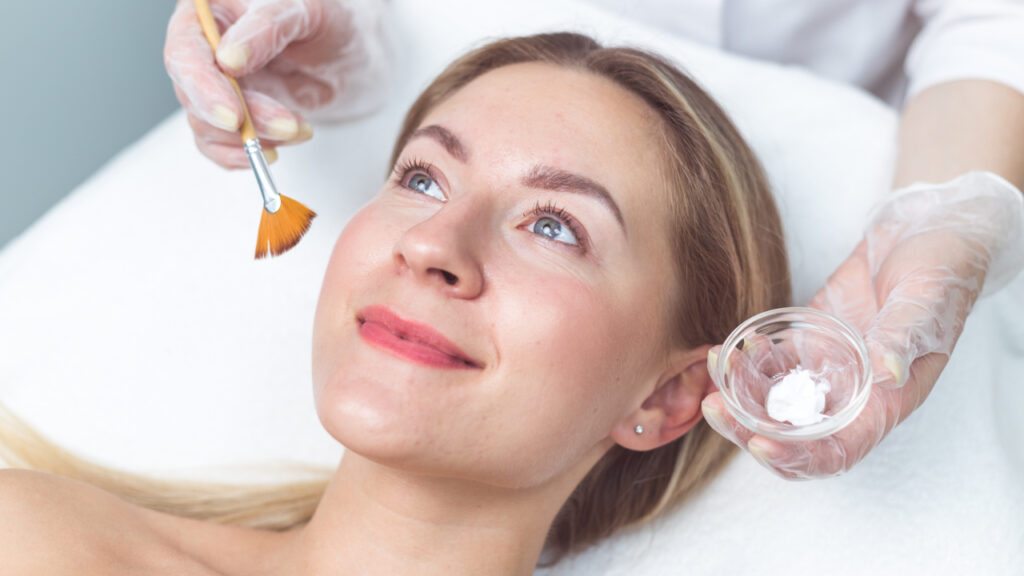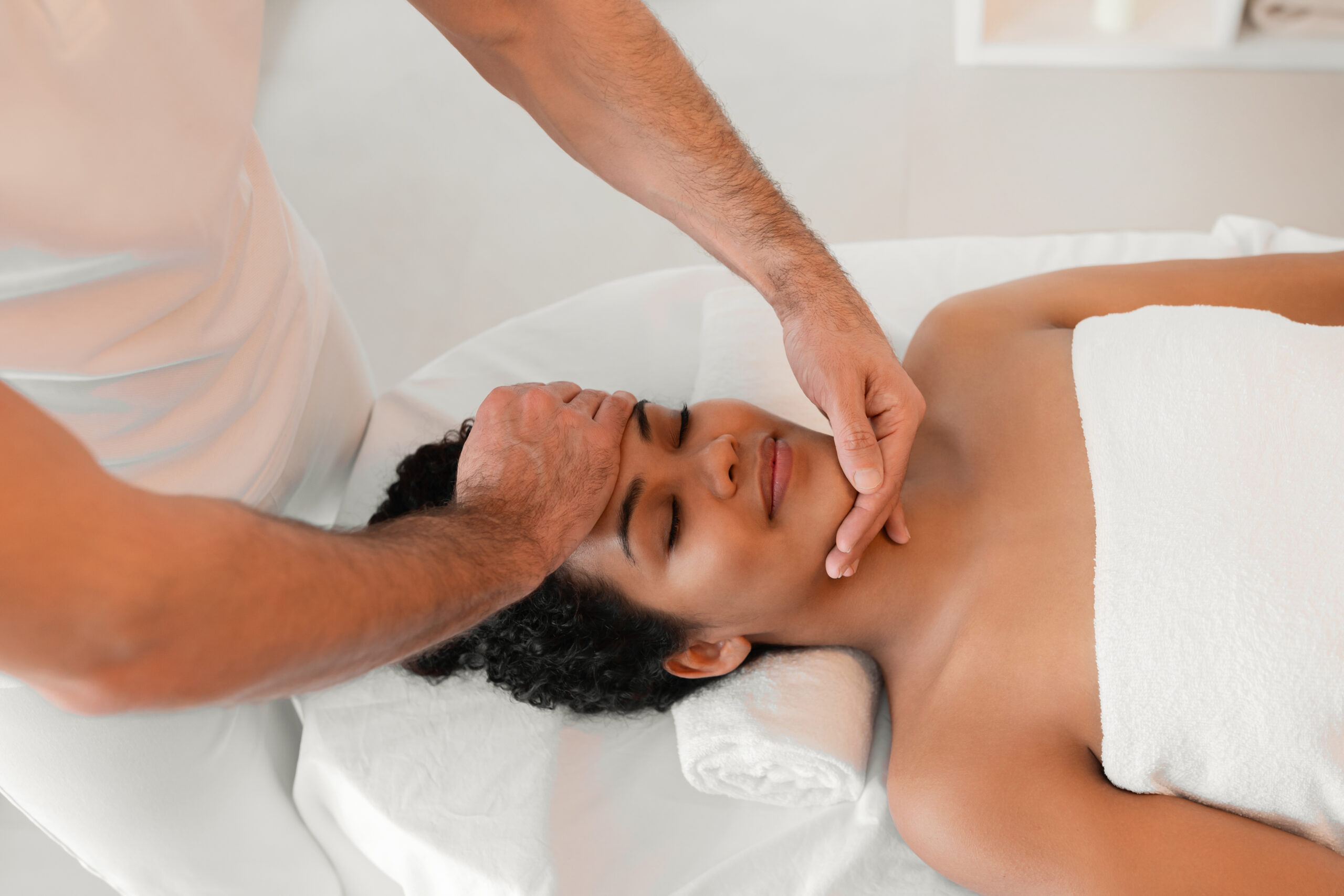Understanding Skin Treatments
Picking the right skin treatment can be a game-changer. Facials and medical-grade chemical peels are two popular choices. Both can boost your skin’s look and feel, but they work differently and suit different skin issues. Let’s break down these treatments so you can choose the best one for your skin.
Introduction to Facials
Facials are like a spa day for your face. They clean, exfoliate, and nourish your skin, leaving it clear and hydrated. Facials help with hydration, plumping, and protection by exfoliating, which boosts collagen production. Collagen is the stuff that keeps your skin firm and elastic. As we age, collagen production drops, leading to wrinkles and sagging (Cleveland Clinic).
Monthly facials can complement your at-home skincare routine, helping you achieve your best skin. They improve circulation, deeply cleanse, offer anti-aging perks, and are super relaxing (Begin with Skin MedSpa).
Facials often include steam, extractions, moisturization, and massage, making them a soothing experience.
Introduction to Medical Grade Chemical Peels
Chemical peels are more intense. They use a chemical solution to remove skin layers and promote cell renewal. Different peels target different skin issues, and the right one for you depends on your needs and your provider’s advice.
There are three types of peels: light, medium, and deep. Light peels use salicylic acid, medium peels might have glycolic or trichloroacetic acid, and deep peels use phenol. Deep peels require sedation and careful application in 15-minute intervals.
Chemical peels can make your skin look and feel better by exfoliating with chemical solutions. Costs vary based on location, provider expertise, and peel type. Light peels can be as cheap as $150, while deep peels can go over $3,000. The average cost is around $673, according to the American Society of Plastic Surgeons.
Both facials and chemical peels can be great for your skin. Knowing your skin type and concerns will help you pick the right treatment. Talking to a professional can also give you valuable insights.
Benefits of Facials and Chemical Peels
Taking care of your skin is key to looking youthful and healthy. Regular facials and medical-grade chemical peels are two treatments we highly recommend. Each has its own set of benefits, and understanding these can help you decide which is right for you.
Advantages of Regular Facials
Facials are noninvasive treatments that clean, moisturize, and exfoliate your skin. They help reveal new skin through continuous exfoliation and boost blood circulation, which is crucial for collagen production.
Getting facials regularly, like once a month, can offer many benefits. They support your at-home skincare routine, improve circulation, deeply cleanse, provide anti-aging benefits, and promote relaxation (Begin with Skin MedSpa).
Facials also hydrate, plump, and protect your skin by boosting collagen production. As we age, collagen production decreases, leading to wrinkles and sagging (Cleveland Clinic).
Medical facials at Advanced Dermatology are more intense than those at spas or with at-home products. They use medical-quality tools and products to cleanse, exfoliate, moisturize, perform extractions, and help erase signs of aging, stress, and environmental damage (Advanced Dermatology).
Benefits of Medical Grade Chemical Peels
Chemical peels are effective treatments that remove damaged outer skin layers to improve texture, tone, reduce lines and wrinkles, and give a more youthful appearance.
Chemical peels work by applying a solution to the skin, which eventually peels off. The new skin is usually smoother and less wrinkled. The intensity of the peel can be adjusted to meet your specific needs, allowing for a highly personalized treatment.
In summary, both facials and chemical peels offer significant benefits for maintaining and improving your skin’s health and appearance. The ideal treatment depends on your skin type, needs, and aesthetic goals. By understanding the benefits of each, you can make an informed decision.
Choosing Between Facials and Chemical Peels
Deciding on the best skin treatment can be tough, especially when comparing facials and chemical peels. Each has unique benefits and suits different skin types and concerns. Let’s look at the factors to consider when choosing between these treatments and how to tailor them to your skin type.
Factors to Consider
When choosing a skin treatment, it’s important to understand the differences. Facials are noninvasive treatments that clean, moisturize, and exfoliate your skin. They help reveal new skin through continuous exfoliation and boost blood circulation, which is crucial for collagen production.
Chemical peels use a chemical solution to remove skin layers and promote cell renewal. These are more intensive treatments compared to facials, which are topical treatments that include steam, extractions, moisturization, and massage for a relaxing experience.
| Treatment | Approach | Intensity |
|---|---|---|
| Facial | Topical, noninvasive | Low |
| Chemical Peel | Chemical solution, invasive | High |
Consider your lifestyle and skincare goals when deciding between the two. If you want a relaxing experience with gentle skincare benefits, a facial might be your best bet. But if you’re looking to address specific skin issues like acne scars, wrinkles, or hyperpigmentation, a chemical peel may be more effective.
Tailoring Treatments to Skin Type
Understanding your skin type is crucial in deciding between a facial and a chemical peel. Facials can be tailored to most skin types and needs, making them a versatile option. However, if you have sensitive skin, you may want to opt for a mild facial to avoid irritation.
Chemical peels, while more intensive, can offer significant benefits for certain skin types. For example, a chemical peel can be effective for oily and acne-prone skin, as it removes dead skin cells and unclogs pores. However, chemical peels may not be suitable for very sensitive skin.
Best results come from consulting with an experienced Medical Aesthetician to determine the most suitable chemical peel based on your skin needs and sensitivities. These professionals can customize peels accordingly (Donaldson Plastic Surgery).
In conclusion, both facials and chemical peels can enhance your skin’s health and appearance. Understanding your skin type and treatment goals will help guide your decision. Consulting with skincare professionals will also ensure you choose the treatment that best meets your needs.
Preparing for Skin Treatments
When considering either a facial or a medical-grade chemical peel, it’s important to know how to prepare your skin. Following certain pre-treatment steps can ensure the procedure’s effectiveness and limit potential side effects.
Pre-Treatment Steps for Facials
Facials require less rigorous preparation compared to chemical peels. Here are some general guidelines to follow before a facial:
- Cleanse Your Skin: Before your appointment, cleanse your skin with a gentle, non-irritating cleanser. This removes any dirt, oil, or makeup that could interfere with the treatment.
- Avoid Exfoliation: Don’t use any exfoliating products on your face for a few days before the treatment. Over-exfoliation can leave your skin sensitive and more prone to irritation.
- Disclose Your Skincare Routine: Inform your facial provider about any skincare products or medications you’re using. Products with ingredients like retinols or alpha hydroxy acids (AHAs) may need to be discontinued to avoid sensitivity or irritation.
Everyone’s skin is different, so consult with your aesthetician for personalized advice on preparing for your facial.
Pre-Treatment Steps for Chemical Peels
Chemical peels require more specific preparation due to their strength and depth. Here are some key steps to follow before a chemical peel:
- Consultation: Before a chemical peel, a consultation with a skincare specialist is necessary to determine the best treatment option and evaluate factors that could interfere with the peel.
- Adjust Skincare Routine: Avoid exfoliation for at least seven days before the treatment and skip skincare products with exfoliating effects.
- Avoid Certain Medications: Don’t use anti-aging or anti-acne medications that can affect the treatment’s efficacy. Follow the doctor’s instructions for painkillers or sedatives (Healthline).
- Refrain from Sun Exposure: Avoid sun exposure and tanning beds for at least a week before your treatment. Sun-damaged skin may not respond well to a chemical peel and can increase the risk of complications.
Preparation for both facials and chemical peels is crucial for optimal results. By following these guidelines and discussing your skincare concerns and goals with your aesthetician, you’re on your way to healthier, more radiant skin.
Aftercare and Recovery
Proper aftercare and recovery are key aspects of any skin treatment. Let’s explore what these involve after getting a facial and a chemical peel.
Post-Facial Skin Care
After a facial, follow a specific skincare routine to maximize the benefits. This typically involves using a gentle cleanser, applying a hydrating moisturizer, and using sunscreen with at least SPF 30. Avoid harsh skincare products, like exfoliants or retinoids, for at least 48 hours. Let your skin rest and recover, and enjoy the glowing results.
Recovery from Chemical Peels
Recovery time after a chemical peel varies based on the type of peel. After a light peel, recovery is about four to seven days. Medium peels take around five to seven days, with redness that may last for months. Deep peels can cause severe swelling and redness, with a recovery time of about two weeks.
| Type of Peel | Recovery Time |
|---|---|
| Light Chemical Peel | 4-7 days |
| Medium Chemical Peel | 5-7 days (redness may persist for months) |
| Deep Chemical Peel | About 2 weeks (severe swelling and redness) |
Don’t pick at your skin during the peeling process, as it slows recovery and increases the risk of infection or irritation. Moisturizing is essential post-peel to maintain hydration and promote effective recovery.
Clients typically wait four to six weeks between peels to allow their skin to heal. Spacing out treatments also helps evaluate progress toward skin health goals.
While chemical peels offer many benefits, they can also lead to serious risks and side effects, including changes in skin color and scarring. These effects can be permanent.
Lastly, chemical peels are usually not covered by insurance as they are considered cosmetic treatments. Consider all these factors when deciding between facials and chemical peels.
Risks and Complications
While both facials and chemical peels are generally safe, they come with potential risks and complications. Understanding these risks can help you make an informed decision.
Potential Risks of Facials
Facials are low-risk treatments, but issues can arise if not performed correctly or if your skin reacts negatively to a product.
Some potential risks include:
- Irritation or redness
- Allergic reactions to products
- Breakouts
- Skin damage from aggressive exfoliation
To minimize these risks, have your facial performed by a trained professional who understands skin types and conditions. At our clinic, we always conduct a thorough skin analysis before any treatment and use only high-quality, tested products.
Possible Complications from Chemical Peels
Chemical peels, while effective, come with a higher risk of complications compared to facials. These can range from minor irritations to more severe issues, such as skin edema, burning and itching, blistering, anaphylaxis, ocular mucosal splashes, cardiac arrhythmias, systemic toxicity, infections, hyperpigmentation, hypopigmentation, and incomplete responses.
Deeper peels provide more marked results but also have a higher incidence of complications, which can be life-threatening in rare cases. Complications are more likely with darker skin types, certain peeling agents, and sun exposure.
Individuals with darker skin tones have a greater risk of post-inflammatory hyperpigmentation from chemical peels. Less aggressive treatments may be recommended for these individuals.
Chemical peels are usually not covered by insurance as they are considered cosmetic treatments (Cleveland Clinic).
Despite these risks, when performed by a trained professional, chemical peels can be a safe and effective treatment for various skin conditions, including acne, melasma, wrinkles, actinic keratosis, pigmentation disorders, and acne scars (NCBI Bookshelf).
Post-treatment care is crucial to minimize complications and promote effective recovery. Don’t pick at your skin during the peeling process, as it slows recovery and increases the risk of infection or irritation. Moisturizing is essential post-peel to maintain hydration and promote effective recovery.












